Research on the Hydraulic Excitation Characteristics of the Top Cover Caused by the Radial Installation Deviation of the Seal of a 1GW Francis Turbine
Abstract
:1. Introduction
2. Materials and Methods
3. Results
3.1. Effect of Radial Deviation on the External Characteristics of the Francis Turbine
3.2. Influence of Radial Deviations on the Internal Flow Characteristics and Pressure Distribution of the Top Cover
3.3. Distribution of Hydraulic Excitation Force by Different Radial Deviations
4. Conclusions
- As the radial installation deviation increases, the output and efficiency of the Francis turbine both show a decreasing trend. The leakage at the upper crown and lower ring seals slightly increases, while the flow in the pressure balance pipelines decreases slightly. With the increase in radial installation deviation, the radial force acting on the runner increases in a parabolic manner. The radial force is shifted to the direction near the nose of the spiral case.
- Under different radial installation deviations, the installation deviation has little effect on the flow field structure inside the runner, and the pressure distribution in the hub surface of the guide vanes in contact with the top cover and the upper crown chamber is basically consistent. The uniformity of the pressure distribution in the labyrinth seal area in the circumferential direction deteriorates significantly with the increase in radial installation deviation, which is the main reason for the increased radial force acting on the runner.
- With the increase in radial installation deviation, there are significant changes in the waveform of the downstream monitoring point of the labyrinth seal. The waveform of the upstream monitoring point, on the other hand, exhibits 15 large peaks and valleys and 15 small peaks and valleys. The dominant frequency components of the upstream monitoring points include fn, 15 fn, 24 fn, and 30 fn. The dominant frequency components of the downstream monitoring points include 15 fn and 30 fn, and there is no fn component caused by radial installation deviation.
Author Contributions
Funding
Data Availability Statement
Conflicts of Interest
Nomenclature
| Z1 | Blade number of stay vane | Fr | Radial force of the runner, ton |
| Z2 | Blade number of guide vane | Fx | X-direction radial force, ton |
| Z3 | Blade number of runner | Fy | Y-direction radial force, ton |
| D1 | Runner inlet diameter, mm | FR1 | Fitted circle’s radius, ton |
| D2 | Runner outlet diameter, mm | ΔP | Variation of pressure, Pa |
| b1 | Runner inlet width, mm | Pi | Pressure value, Pa |
| ΔX | X-direction installation deviation, mm | PBP | Pressure balance pipelines |
| ΔY | Y-direction installation deviation, mm | CFD | Computational fluid dynamics |
| Q | Flow rate, m3/s | SST | Shear Stress Transport |
References
- Zhang, Z.L.; Liu, B.; Wang, F.Q. Innovation and Development of Conventional Hydropower and Pumped-storage Technology in China. Water Power 2023, 1–7. [Google Scholar]
- Zhang, X.Y. Analysis on Structure of Leakage-check Ring and Decompression Device of Upper Runner Crown. Heilongjiang Hydraul. Sci. Technol. 2023, 51, 47–50. [Google Scholar]
- Ma, W.; Liang, W.K.; Nan, H.P.; Zhao, D.L.; Li, J.B.; Dong, Y.T. The influence of sealing clearance value of Francis runner on the unit stability. J. Hydroelectr. Eng. 2010, 29, 219–223. [Google Scholar]
- Zhou, X.; Wu, H.G.; Su, K. Overview and discussion on hydraulic axial thrust in Francis turbine research. J. Hydraul. Eng. 2019, 50, 1242–1252. [Google Scholar]
- Dong, Y.T.; Liang, W.K. Numerical Simulation on the Francis Hydraulic Turbine Runner’s Sealing Device and Relief Pipes. J. Xi’an Univ. Technol. 2008, 2, 1006–4710. [Google Scholar]
- Wang, T.T.; Zhang, C.B.; Xie, T.T.; Cao, W.Z. Analysis on vortex ropes and pressure pulsations in draft tube of variable-speed Francis turbine. J. Hydroelectr. Eng. 2021, 40, 95–101. [Google Scholar]
- Chen, H.; Lu, Y.G.; Liu, K.; Zhang, Z.Z.; Li, H.H.; Huang, X.X.; Zhao, W.Q.; Wang, Z.W. Study on the Internal Flow Characteristics of Long and Short Blade Runners of a 1000 MW Francis Turbine under Different Opening Conditions. Processes 2023, 11, 1796. [Google Scholar] [CrossRef]
- Yu, A.; Wang, Y.; Tang, Q.; Lv, R.; Yang, Z. Investigation of the vortex evolution and hydraulic excitation in a pump-turbine operating at different conditions. Renew. Energy 2021, 171, 462–478. [Google Scholar] [CrossRef]
- Trivedi, C.; Agnalt, E.; Dahlhaug, O.G. Experimental study of a Francis turbine under variable-speed and discharge conditions. Renew. Energy 2018, 119, 447–458. [Google Scholar] [CrossRef]
- Ji, L.; Xu, L.; Peng, Y.; Zhao, X.; Li, Z. Experimental and numerical simulation study on the flow characteristics of the draft tube in Francis turbine. Machines 2022, 10, 230. [Google Scholar] [CrossRef]
- Ji, Z.; Shi, Y.; Da, X.; Cao, J.; Gong, Q.; Wang, Z.; Huang, X. Influence of Installation Deviation of Thrust Bearing on Oil Film Flow of 1000 MW Hydraulic Turbine Unit. Water 2023, 15, 1649. [Google Scholar] [CrossRef]
- Li, Q.F.; Zhang, Y.P.; Min, Z.; Li, Z.G.; Deng, Y.X.; Dong, Z.Q. Analysis of sealing clearance flow of mixed-flow pump-turbine. J. Lanzhou Univ. Technol. 2016, 42, 51–55. [Google Scholar]
- Wang, Y.; Jin, K.; Huang, X.; Lin, P.; Wang, Z.; Wang, W.; Zhou, L. Influence of Radial Installation Deviation on Hydraulic Thrust Characteristics of a 1000 MW Francis Turbine. Water 2023, 15, 1606. [Google Scholar] [CrossRef]
- Wu, Z.J.; Liang, W.K.; Dong, W.; Gao, C.H.; Chen, D.Y. Influence of seal clearance of runner on internal fluid field in Francis turbine. Trans. Chin. Soc. Agric. Eng. 2020, 36, 23–29. [Google Scholar]
- Acharya, N.; Gautam, S.; Chitrakar, S.; Trivedi, C.; Dahlhaug, O.G. Leakage Vortex Progression through a Guide Vane’s Clearance Gap and the Resulting Pressure Fluctuation in a Francis Turbine. Energies 2021, 14, 4244. [Google Scholar] [CrossRef]
- Li, D.; Zhang, N.; Jiang, J.; Gao, B.; Anthony, A.; Zhou, W.; Shi, J. Numerical investigation on the unsteady vortical structure and pressure pulsations of a centrifugal pump with the vaned diffuser. Int. J. Heat Fluid Flow 2022, 98, 109050. [Google Scholar] [CrossRef]
- Dehkharqani, S.A.; Engström, F.; Aidanpää, O.J. Experimental Investigation of a 10 MW Prototype Axial Turbine Runner: Vortex Rope Formation and Mitigation. J. Fluids Eng. 2020, 142, 101212. [Google Scholar] [CrossRef]
- Xu, L.; Guo, T.; Wang, W. Effects of Vortex Structure on Hydraulic Loss in a Low Head Francis Turbine under Overall Operating Conditions Base on Entropy Production Method. Renew. Energy 2022, 198, 367–379. [Google Scholar]
- Juposhti, H.J.; Maddahian, R.; Cervantes, M.J. Optimization of axial water injection to mitigate the Rotating Vortex Rope in a Francis turbine. Renew. Energy 2021, 175, 214–231. [Google Scholar] [CrossRef]
- Shubham, S.; Bhupendra, K. Assessment of erosion wear in low specific speed Francis turbine due to particulate flow. Adv. Powder Technol. 2023, 34, 104065. [Google Scholar]
- Masoud, S.; Ebrahim, H.; Alireza, R.; Amir, H. Optimal condition of simultaneous water and air injection in a Francis turbine in order to reduce vortices using experimental and numerical methods. Energy Convers. Manag. 2023, 291, 117305. [Google Scholar]
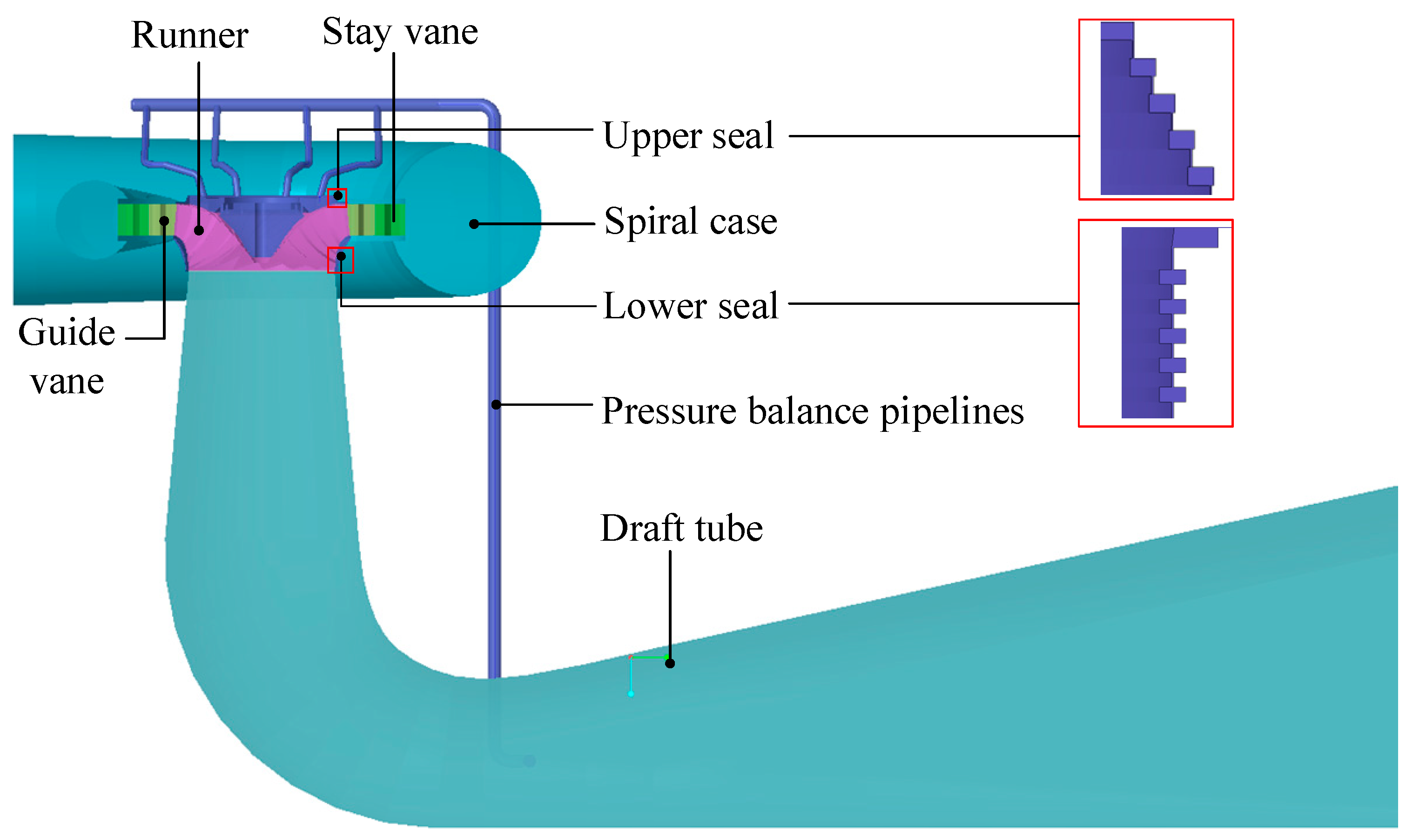
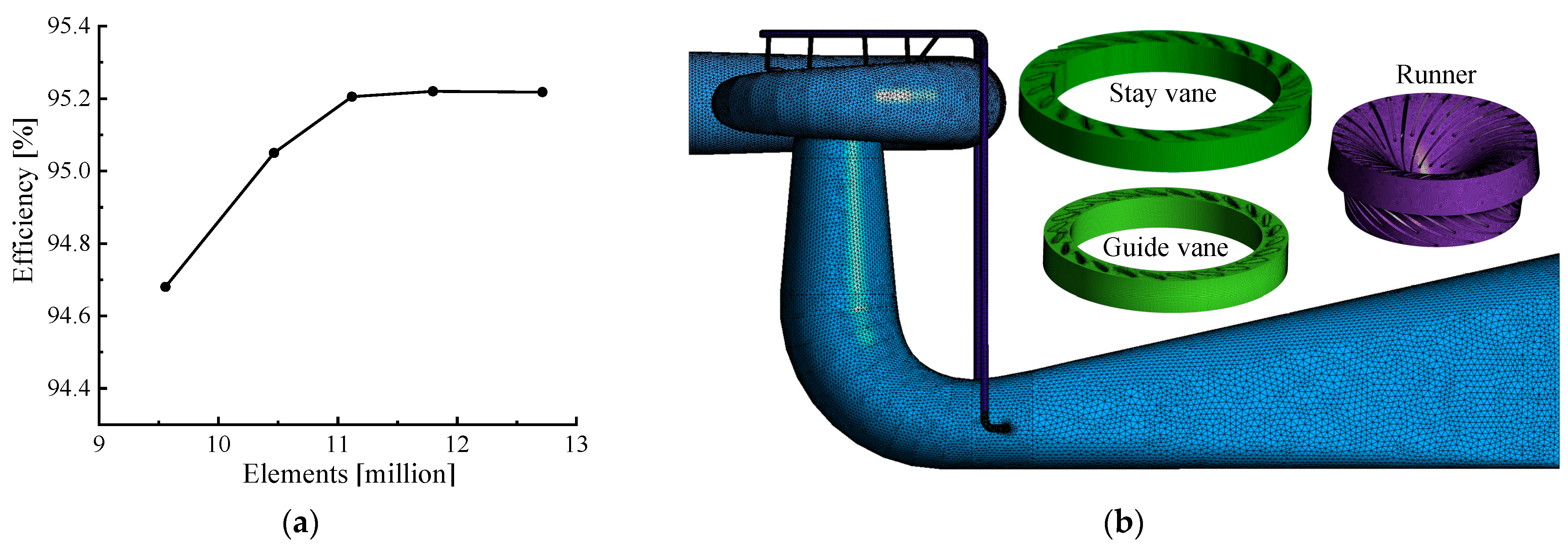
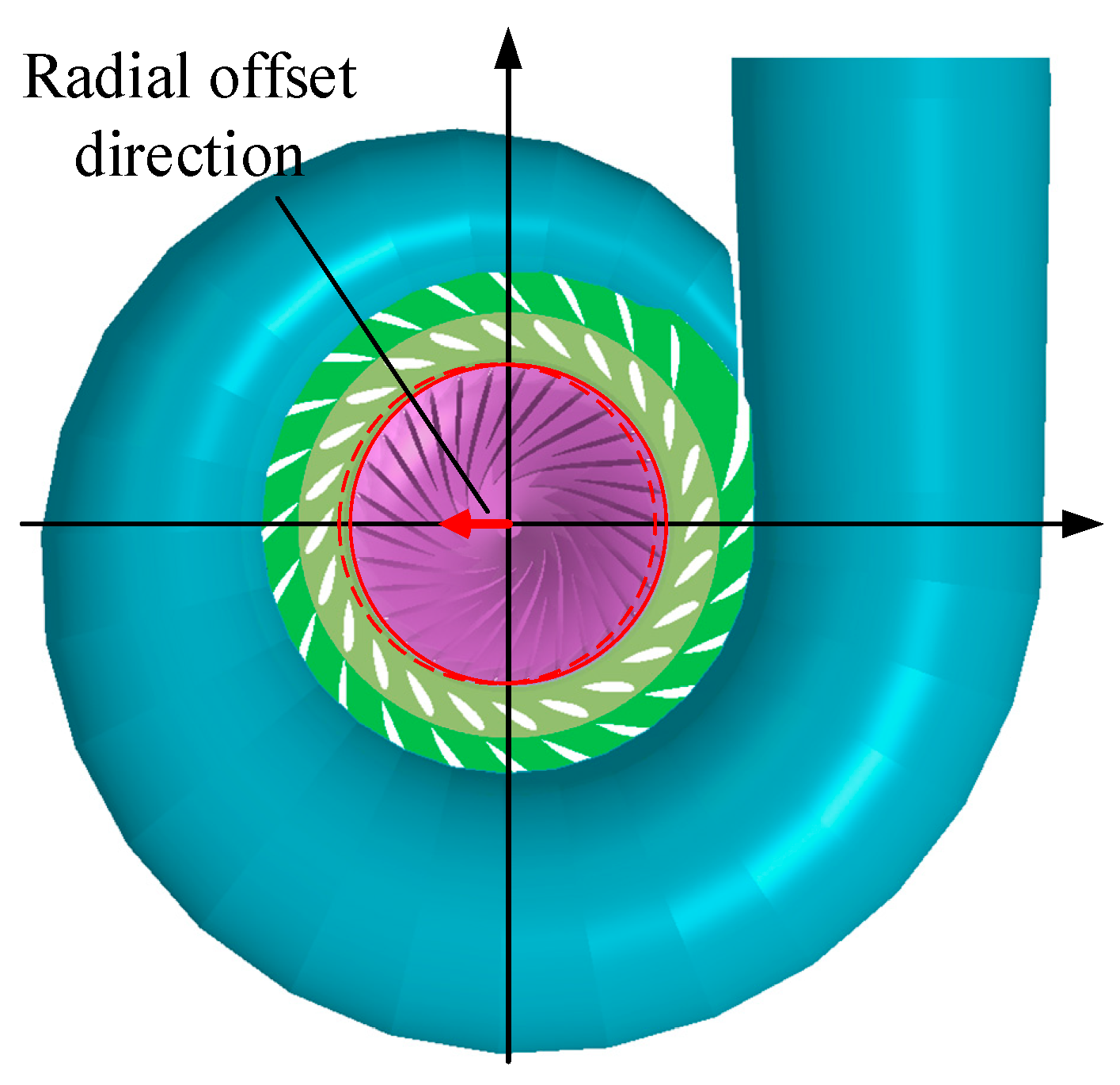
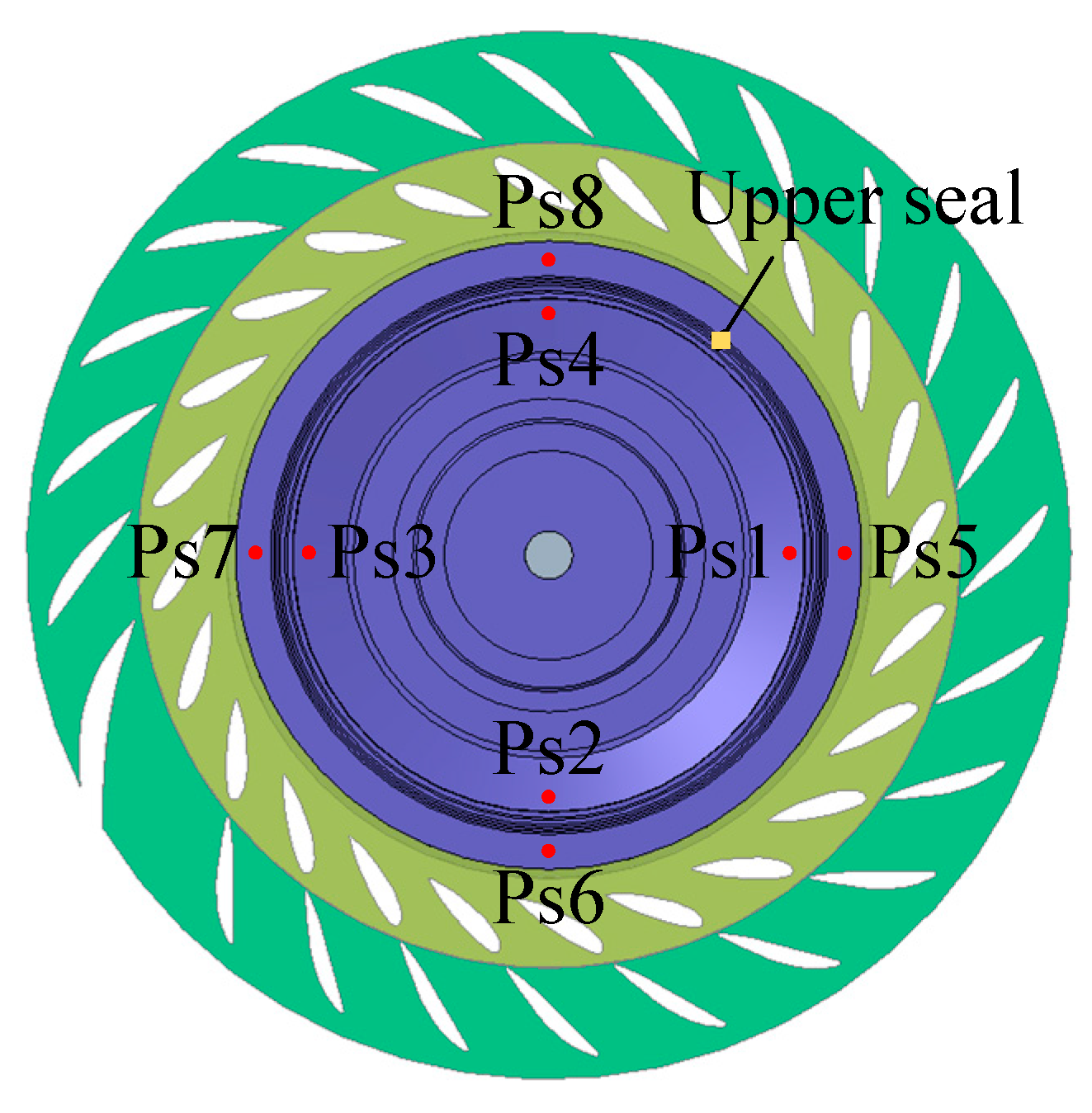

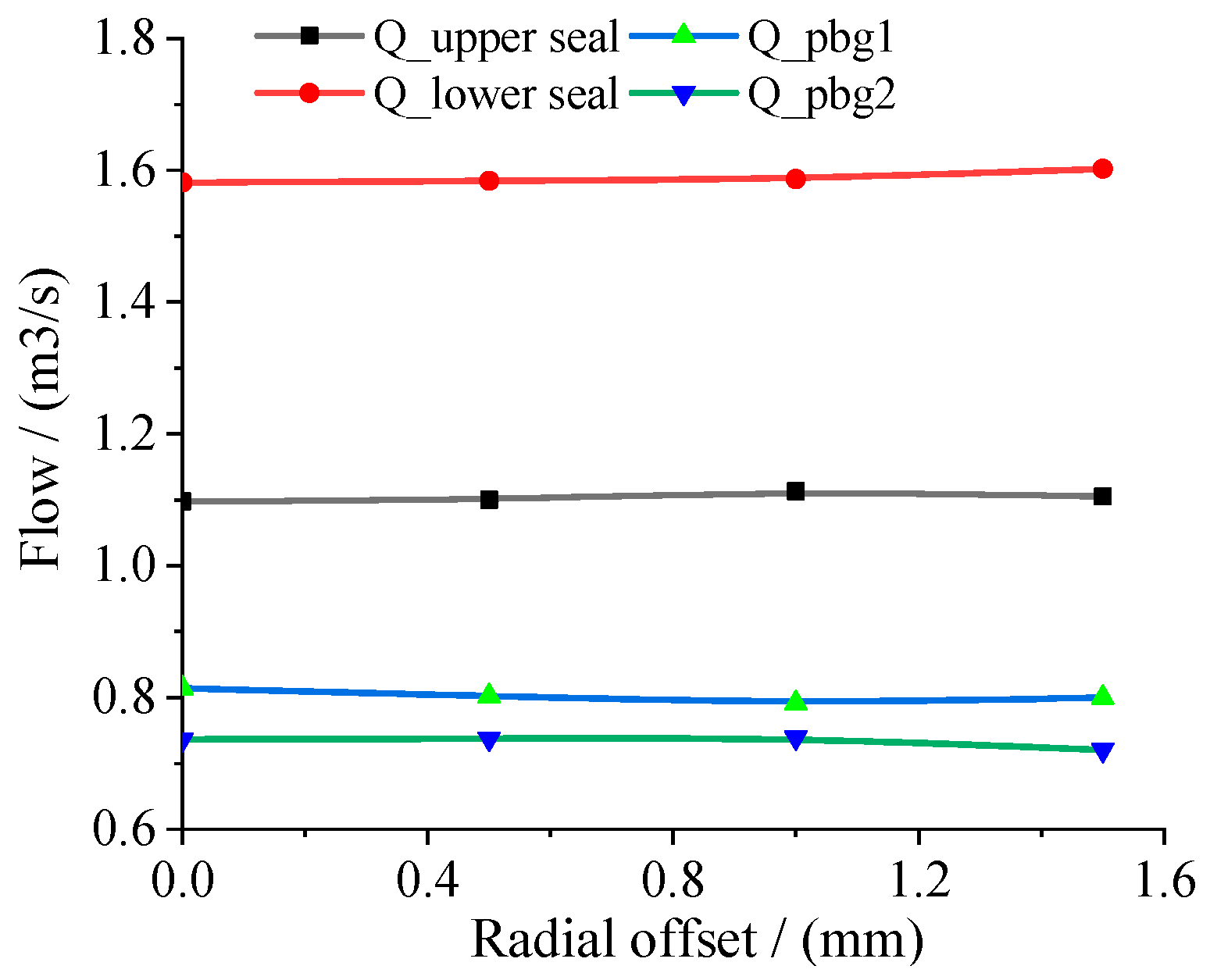
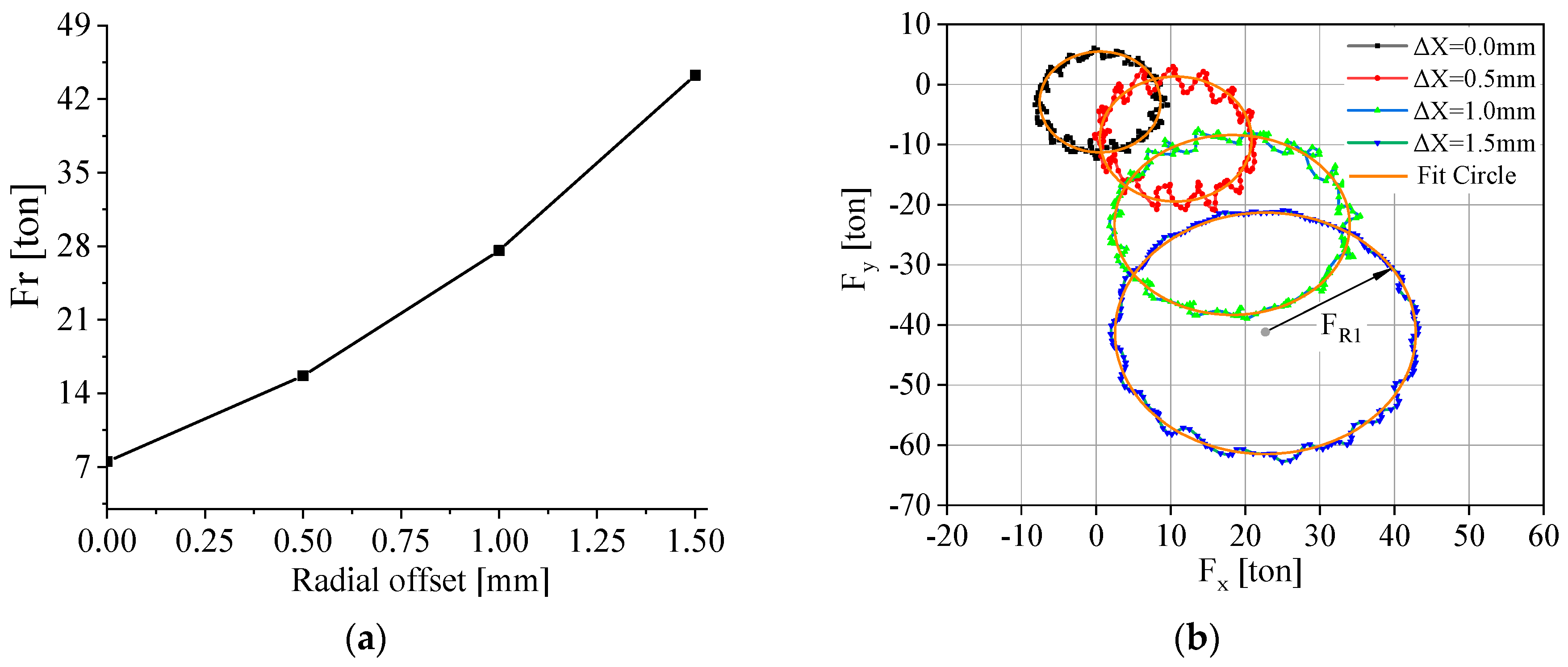





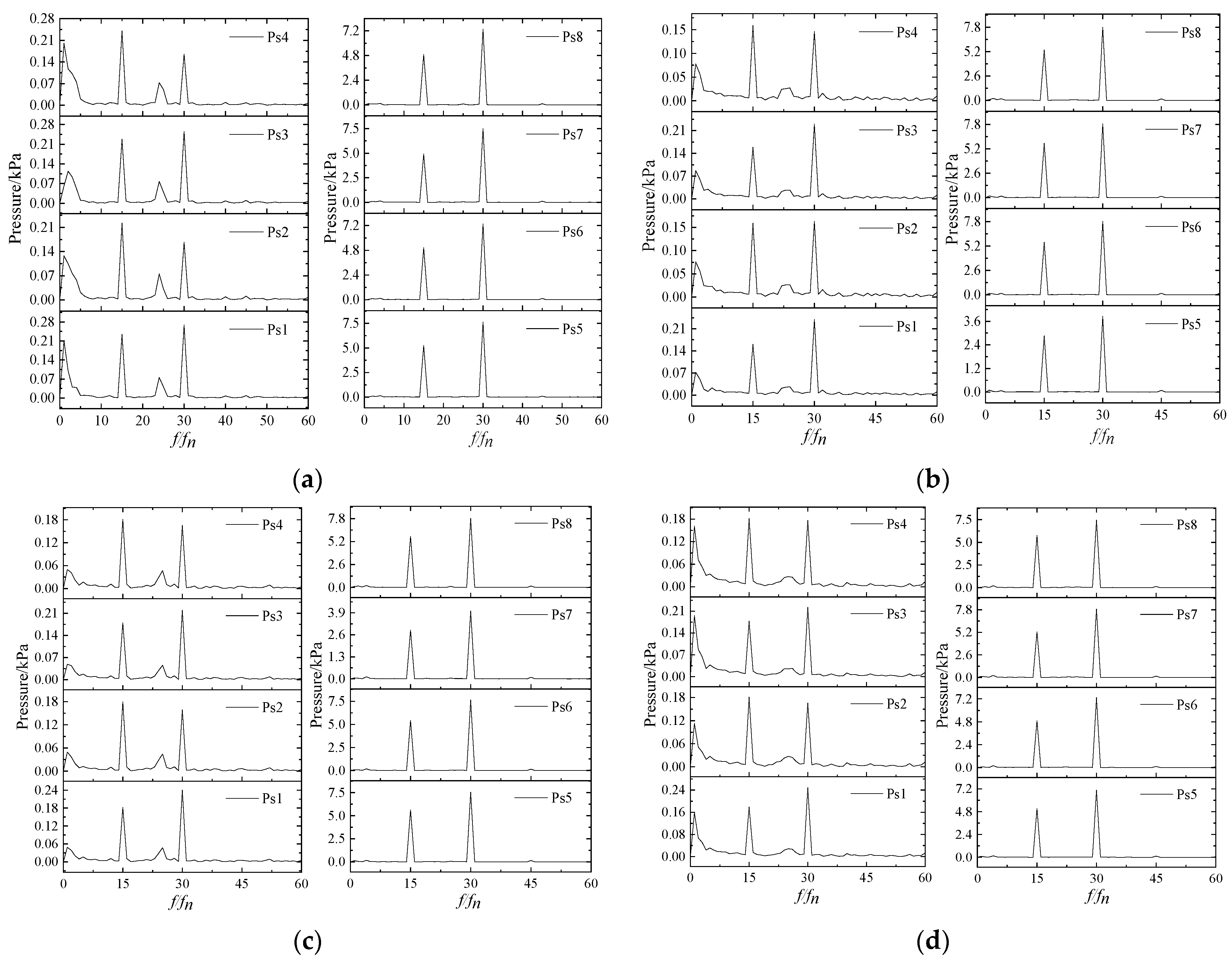
| Parameters | Value | Parameters | Value |
|---|---|---|---|
| Blade number of stay vane, Z1 | 23 | Runner inlet diameter, D1 | 8710 mm |
| Blade number of guide vane, Z2 | 24 | Runner outlet diameter, D2 | 7340 mm |
| Blade number of runner, Z3 | Long 15 + short 15 | Runner inlet width, b1 | 1570 mm |
Disclaimer/Publisher’s Note: The statements, opinions and data contained in all publications are solely those of the individual author(s) and contributor(s) and not of MDPI and/or the editor(s). MDPI and/or the editor(s) disclaim responsibility for any injury to people or property resulting from any ideas, methods, instructions or products referred to in the content. |
© 2023 by the authors. Licensee MDPI, Basel, Switzerland. This article is an open access article distributed under the terms and conditions of the Creative Commons Attribution (CC BY) license (https://creativecommons.org/licenses/by/4.0/).
Share and Cite
Jin, K.; Lu, Y.; Lin, P.; Zhang, Z.; Li, J.; Zhao, Y.; Huang, X.; Wang, Z. Research on the Hydraulic Excitation Characteristics of the Top Cover Caused by the Radial Installation Deviation of the Seal of a 1GW Francis Turbine. Processes 2023, 11, 3172. https://doi.org/10.3390/pr11113172
Jin K, Lu Y, Lin P, Zhang Z, Li J, Zhao Y, Huang X, Wang Z. Research on the Hydraulic Excitation Characteristics of the Top Cover Caused by the Radial Installation Deviation of the Seal of a 1GW Francis Turbine. Processes. 2023; 11(11):3172. https://doi.org/10.3390/pr11113172
Chicago/Turabian StyleJin, Kun, Yonggang Lu, Peng Lin, Zequan Zhang, Juan Li, Yun Zhao, Xingxing Huang, and Zhengwei Wang. 2023. "Research on the Hydraulic Excitation Characteristics of the Top Cover Caused by the Radial Installation Deviation of the Seal of a 1GW Francis Turbine" Processes 11, no. 11: 3172. https://doi.org/10.3390/pr11113172






